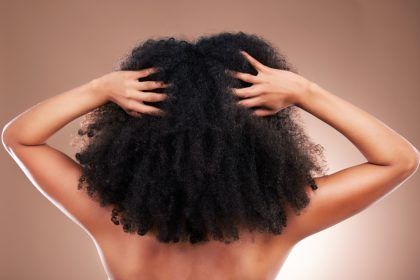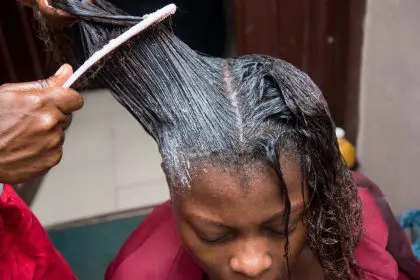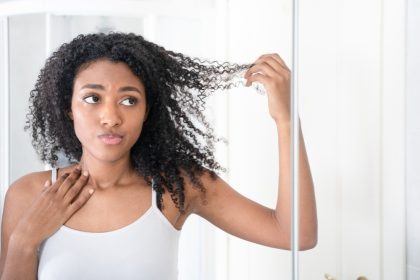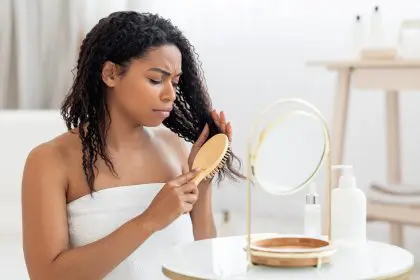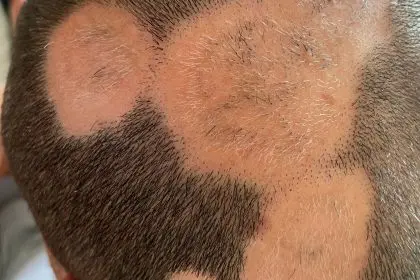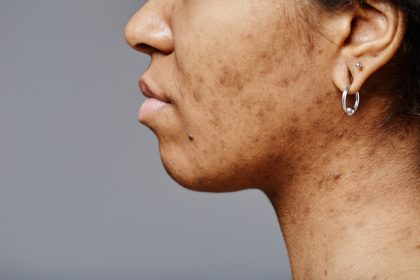Common daily routines that silently destroy hair follicles and trigger premature hair loss in young adults
Something alarming is happening to the hairlines of people barely out of their teens. Walk through any college campus or young professional workplace, and you’ll notice an increasing number of individuals in their twenties dealing with significant hair loss that previous generations didn’t experience until their forties or fifties.
This premature balding epidemic isn’t just affecting men. Women are also experiencing unprecedented rates of early hair thinning and loss, often feeling confused and distressed as their once-thick hair becomes noticeably sparse before they’ve even reached their thirties.
The culprit behind this widespread early hair loss isn’t genetics, hormones, or mysterious medical conditions. Instead, it’s a seemingly innocent daily habit that most people perform without giving it a second thought. This routine behavior has become so normalized in modern society that few recognize its devastating impact on hair health and longevity.
Understanding this destructive habit and its mechanisms can mean the difference between maintaining a full head of hair well into older age and facing premature baldness in your twenties. The good news is that once you recognize what’s causing the damage, you can take immediate steps to protect your hair and potentially reverse some of the harm already done.
The hidden destroyer living in your daily routine
The most significant contributor to premature hair loss in young adults is excessive heat styling, but not in the way most people understand it. While everyone knows that high temperatures can damage hair, the real problem lies in the frequency and cumulative nature of daily heat exposure that slowly destroys hair follicles over time.
The average young adult now uses heat styling tools almost daily, creating a constant cycle of damage and attempted repair that ultimately overwhelms the hair’s natural ability to maintain itself. This isn’t just about occasional blow-drying or special occasion styling. It’s about the relentless daily assault on hair follicles through multiple heat sources throughout the day.
Morning routines typically begin with hot showers followed immediately by blow-drying, often at high temperatures to speed up the process. Many people then use flat irons, curling wands, or other heated tools to achieve their desired style. This double or triple heat exposure within a single morning routine creates more damage than hair follicles can repair overnight.
The temperature levels commonly used in daily styling routines reach between 300 to 450 degrees Fahrenheit. To put this in perspective, these temperatures are hot enough to cook food. When applied repeatedly to the delicate structures that produce hair, the results are predictably devastating.
What makes this habit particularly insidious is that the damage accumulates gradually. Unlike a dramatic haircut or color change that produces immediate visible results, heat damage builds slowly over months and years until suddenly the hair loss becomes undeniable.
How daily heat exposure destroys hair follicles
Heat styling doesn’t just damage the visible hair shaft that you can see and touch. It penetrates deep into the scalp, affecting the follicles themselves and disrupting the complex biological processes that produce healthy hair growth.
When high temperatures are repeatedly applied to the scalp area, they cause inflammation in the hair follicles. This chronic inflammation gradually weakens the follicles’ ability to produce strong, healthy hair strands. Over time, inflamed follicles begin producing progressively thinner and weaker hairs until they eventually stop producing hair altogether.
The protein structures that give hair its strength and flexibility begin to break down under repeated heat exposure. These proteins, once damaged, cannot fully repair themselves. Each heat styling session adds to the cumulative damage, creating a progressive weakening effect that compounds over time.
Heat also disrupts the natural oil production in the scalp. The sebaceous glands that produce protective oils for hair and scalp health can become overactive or underactive in response to frequent temperature extremes. This disruption affects the scalp’s ability to maintain a healthy environment for hair growth.
The blood vessels that supply nutrients to hair follicles can also be affected by repeated heat exposure. When these tiny blood vessels are repeatedly dilated and constricted by temperature changes, their ability to deliver essential nutrients to hair follicles becomes compromised.
Additionally, heat styling often requires pulling, tugging, and manipulating hair while it’s in a weakened state from the high temperatures. This mechanical stress combines with heat damage to create even more follicle trauma and accelerated hair loss.
The moisture depletion cycle that kills hair
One of the most destructive aspects of daily heat styling is how it creates a vicious cycle of moisture depletion that becomes increasingly difficult to break. Hair naturally contains a specific moisture content that maintains its flexibility, strength, and healthy appearance. Heat styling rapidly removes this moisture, leaving hair brittle and vulnerable.
When hair loses its natural moisture content, it becomes more susceptible to breakage, split ends, and follicle damage. Many people respond to this dryness by applying more heat to try to smooth and style their increasingly unmanageable hair, creating a destructive feedback loop.
The cuticle layer of each hair strand, which acts as a protective barrier, becomes damaged when repeatedly exposed to high temperatures. Once this protective layer is compromised, moisture escapes more easily while environmental pollutants and damaging substances can penetrate more readily.
Dehydrated hair follicles cannot function properly. They require adequate moisture to produce healthy hair cells and maintain normal growth cycles. When follicles become chronically dehydrated from repeated heat exposure, they begin to shut down their hair production processes.
The scalp itself also suffers from moisture depletion. A dry, irritated scalp creates an unhealthy environment for hair growth and can trigger inflammatory responses that further damage follicles. This scalp dryness often leads people to wash their hair more frequently, which ironically exposes it to more heat during the drying process.
Many people attempt to combat heat damage by using leave-in treatments and protective products, but these cannot fully compensate for the moisture loss and protein damage caused by daily high-temperature styling. The protection offered by these products is often minimal compared to the intensity of damage being inflicted.
The compound effect of multiple heat sources
Modern hair styling routines rarely involve just one heat source. The typical morning routine exposes hair to multiple temperature extremes that create exponentially more damage than any single heating tool would cause alone.
Hot showers represent the first heat exposure of the day. While the water temperature may seem moderate, prolonged exposure to hot water opens the hair cuticles and makes hair more vulnerable to subsequent heat damage. Hair that is already heat-sensitized from showering becomes even more susceptible to damage from blow-dryers and styling tools.
Blow-drying immediately after hot showers compounds the moisture loss and heat damage. The hair is already in a weakened state from hot water exposure, making it less able to withstand the intense heat and airflow from hair dryers. Many people use blow-dryers on their highest heat settings to speed up the drying process, creating temperatures that exceed what hair can safely tolerate.
Additional styling tools like flat irons and curling wands represent a third layer of heat exposure within a single styling session. By this point, the hair and scalp have already been subjected to significant temperature stress, making this final round of heat styling particularly destructive.
The timing of these multiple heat exposures is also problematic. When heat styling tools are used in rapid succession, the hair doesn’t have time to cool down and recover between applications. This continuous heat exposure is far more damaging than spaced-out styling sessions would be.
Environmental heat sources throughout the day add to the cumulative damage. Sun exposure, heated car interiors, and indoor heating systems all contribute additional temperature stress to hair that has already been compromised by morning styling routines.
Why young adults are most vulnerable
Several factors make young adults particularly susceptible to premature hair loss from heat styling habits. This age group faces unique circumstances that increase both their heat styling frequency and their vulnerability to follicle damage.
Social media culture has created unprecedented pressure for young adults to maintain perfectly styled hair at all times. The need to look camera-ready for spontaneous photos and videos has led many to adopt daily intensive styling routines that previous generations reserved for special occasions.
The transition to adult independence often coincides with increased access to professional-grade styling tools. Many young adults invest in high-end flat irons and blow-dryers without understanding the proper techniques for minimizing damage. These powerful tools can create salon-quality results but also salon-level damage when used improperly.
Busy lifestyles and time constraints lead many young adults to rush through their styling routines, using higher heat settings to achieve faster results. This time pressure often prevents the careful, methodical approach to heat styling that minimizes follicle damage.
Young adults also tend to experiment more with different hairstyles and looks, leading to frequent changes in styling techniques and tools. This experimentation often involves trial and error with various heat styling methods, creating inconsistent and often excessive heat exposure patterns.
The cumulative nature of heat damage means that habits formed in the twenties will have the most significant long-term impact on hair health. Young adults who establish damaging heat styling routines early in life will experience the most severe hair loss as they age.
The invisible early warning signs
Premature hair loss from heat styling doesn’t happen overnight. There are numerous early warning signs that most people either don’t recognize or dismiss as temporary styling challenges. Understanding these subtle indicators can help prevent more serious damage.
Hair texture changes often represent the first sign of heat damage. Hair may become increasingly coarse, dry, or difficult to style. Many people attribute these changes to seasonal variations or temporary stress rather than recognizing them as signs of follicle damage.
Increased hair shedding during washing or brushing indicates weakened hair shafts that are breaking more easily. While some daily hair loss is normal, a noticeable increase in the amount of hair found on pillows, in drains, or on clothing suggests developing problems.
Scalp sensitivity or irritation after heat styling can indicate that follicles are becoming inflamed and damaged. Tingling, burning, or tender feelings on the scalp should be taken seriously as signs that heat exposure is exceeding safe levels.
Changes in hair growth patterns, such as slower regrowth after haircuts or areas that seem to take longer to grow out, can indicate that follicles are beginning to struggle with normal hair production processes.
The appearance of baby hairs or fine, wispy hairs around the hairline often signals that follicles are producing progressively weaker hair strands. These thin hairs represent follicles that are losing their ability to produce normal, healthy hair.
Split ends and breakage that occur despite regular trims indicate that the hair shaft structure is being compromised by excessive heat exposure. Hair that breaks easily or develops split ends shortly after cutting is showing signs of protein damage.
Breaking the destructive cycle
Recognizing heat styling as the primary cause of premature hair loss is the first step toward protecting your hair and potentially reversing existing damage. However, breaking free from daily heat styling habits requires strategic planning and gradual changes rather than abrupt elimination of all styling tools.
Temperature reduction represents the most immediate and effective change most people can make. Lowering heat styling tool temperatures by even 50 degrees can significantly reduce follicle damage while still achieving acceptable styling results. Most hair types can be effectively styled at much lower temperatures than commonly used.
Frequency reduction is equally important. Moving from daily heat styling to every other day or every few days gives hair follicles crucial recovery time. During non-heat styling days, alternative styling methods like braiding, air-drying techniques, or protective styles can maintain appearance without causing additional damage.
Timing changes can also reduce cumulative heat exposure. Allowing hair to air-dry partially before using blow-dryers reduces the duration of heat exposure needed. Similarly, spacing out different heat styling tools rather than using them in immediate succession allows hair to cool and recover between applications.
Heat protectant products, while not a complete solution, can provide some additional protection when used properly. These products should be applied to damp hair before any heat styling and reapplied between different styling tools to maximize their protective benefits.
Professional guidance can help identify the most damaging aspects of individual styling routines. Many people unknowingly use techniques or settings that create unnecessary damage, and small adjustments can significantly reduce harm while maintaining desired results.
Natural alternatives that actually work
Developing effective heat-free styling techniques is essential for breaking the cycle of heat-induced hair loss. These methods may require more initial time investment but often produce longer-lasting results with significantly less damage.
Wet setting techniques using rollers, pin curls, or braiding can create lasting waves and curls without any heat exposure. These methods work by setting hair in the desired shape while wet and allowing it to dry naturally into the formed pattern.
Air-drying methods can be enhanced with specific techniques that create volume and style without heat tools. Plopping, scrunching, and strategic product placement can achieve salon-worthy results using only natural drying processes.
Protective styling options like braids, buns, and twists can create polished looks while giving hair a complete break from heat exposure. These styles often last multiple days, reducing the frequency of styling manipulation overall.
Natural texture enhancement rather than fighting against your hair’s natural patterns often produces better results with less effort and damage. Working with your hair’s natural tendencies rather than forcing it into unnatural shapes reduces the need for extreme heat styling.
Overnight styling techniques can create beautiful results with minimal morning effort. Setting hair in loose braids, using silk pillowcases, or employing other overnight methods can wake up to styled hair without any heat exposure.
Reversing existing damage and preventing future loss
While some heat damage is permanent, many aspects of hair health can be improved with proper care and the elimination of destructive styling habits. Hair follicles have remarkable regenerative abilities when given the opportunity to recover from chronic stress.
Scalp health improvement through gentle massage, proper nutrition, and reduced heat exposure can help damaged follicles begin producing healthier hair. This process takes time, as hair growth cycles typically span several months, but improvements often become visible within a few months of changing habits.
Protein treatments can help temporarily strengthen damaged hair shafts, though they cannot reverse structural damage completely. These treatments are most effective when combined with reduced heat styling rather than used as a way to continue damaging habits.
Deep conditioning and moisture restoration treatments help repair some of the dehydration damage caused by excessive heat styling. Regular deep conditioning can improve hair flexibility and reduce breakage, though it cannot restore severely damaged follicles.
Gentle handling techniques become especially important for heat-damaged hair. Using wide-tooth combs, minimizing brushing when wet, and avoiding tight hairstyles helps prevent additional mechanical damage to already compromised hair.
Nutritional support through proper diet and hydration provides follicles with the building blocks needed for healthy hair production. Hair follicles are among the most metabolically active cells in the body and require adequate nutrition to function properly.
The journey from heat-damaged hair to healthy, strong hair requires patience and consistency. However, young adults who make these changes early in life can prevent decades of progressive hair loss and maintain fuller hair well into their later years. The choice to continue damaging heat styling habits or protect your hair’s future ultimately determines whether you’ll face premature baldness or enjoy a lifetime of healthy hair.


